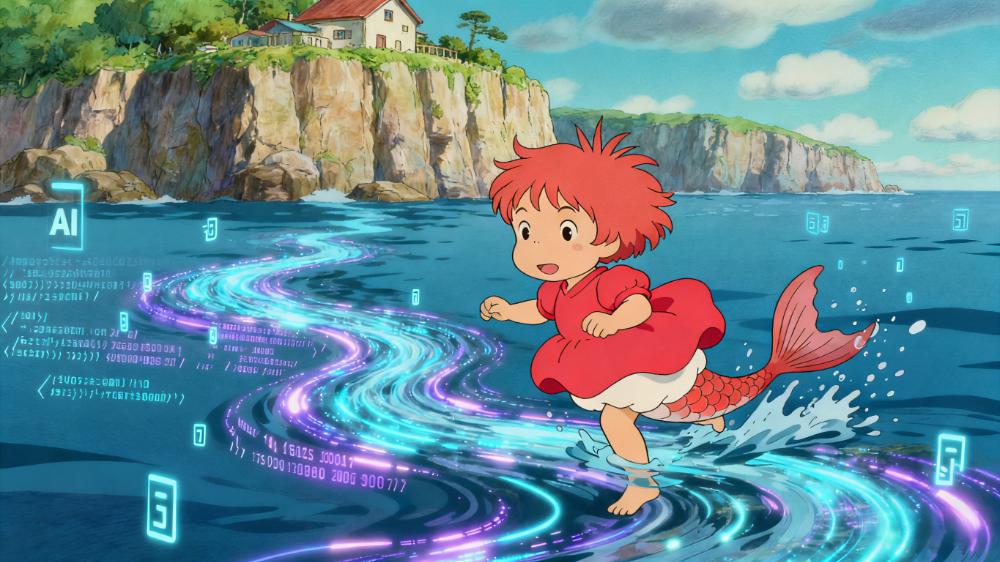Algorithm Learning: The Decoding Process from Pixels to Emotion
Traditional image processing technology can only recognize colors and shapes, but AI art systems need to understand deeper artistic language. Taking Ghibli's hand-drawn style as an example, the system first analyzes tens of thousands of original drawings, learning the thickness variations of lines, the gradient patterns of colors, and the treatment of light and shadow. But this isn't enough—the real challenge lies in understanding emotional expression.
When Miyazaki draws a cloud, he's not just depicting shape, but conveying a feeling of lightness and freedom. Through deep learning, AI systems gradually learn to recognize this emotional pattern: warm tones represent safety and hope, flowing lines suggest life and vitality, soft shadows create tranquility and mystery. This leap from technology to art is the core of the AI art revolution.
Take GhibliAi as an example. After millions of training sessions, the system can distinguish the emotional needs of different scenes: forest scenes require warm and mysterious green tones, urban scenes need complex and ordered geometric lines, sky scenes need infinitely extending gradient colors. This emotional understanding makes AI-generated works no longer cold algorithmic products, but artistic creations with warmth.
Style Inheritance: Digital Recreation of Hand-drawn Warmth
The most charming aspect of Ghibli animation lies in every frame carrying the temperature of hand-drawing—those imperfect lines, slight tremors, subtle color variations are precisely the artistic soul that machines find difficult to replicate. But AI art is breaking through this limitation.
By analyzing the drawing habits of masters like Miyazaki and Takahata, AI systems learn to simulate the randomness of hand-drawing: variations in line thickness, slight color deviations, subtle compositional adjustments. These seemingly random elements are actually natural expressions of the artist's emotions. AI simulates this randomness through algorithms, allowing digital works to also possess the breathing of hand-drawing.
Even more astonishing is that AI has learned to understand the personal styles of different artists. Miyazaki's lines are more fluid, his colors warmer; Takahata's compositions are more rigorous, his light and shadow more realistic. AI systems can recognize and recreate these subtle differences, giving each generated work a unique artistic personality.
Creative Boundaries: Collaboration Between AI and Human Artists
The emergence of AI art is not to replace human artists, but to open up a completely new creative mode. On the GhibliAi platform, users can provide their own photos, and the AI system will transform them into Ghibli style, but the final creation still requires human creativity and aesthetic judgment.
This collaborative model makes artistic creation more democratic. In the past, only professionally trained artists could create Ghibli-style works. Now, anyone can express their creativity through AI tools. But this doesn't mean the threshold for art has been lowered; rather, the ways of artistic expression have become more diverse.
AI art also opens up new creative possibilities. Artists can quickly generate numerous drafts and select the most promising ones for in-depth creation; designers can explore different style combinations to create unprecedented visual experiences; ordinary users can transform their memories into artworks, giving ordinary moments extraordinary beauty.
Future Prospects: Infinite Possibilities of AI Art
The development of AI art is still in its early stages, but has already shown tremendous potential. In the future, we may see more intelligent art systems that can not only imitate existing styles but also create entirely new artistic languages.
Imagine AI systems that can learn multiple artists' styles and then create new works that blend different aesthetic characteristics; or AI that can automatically adjust colors and compositions based on users' emotional states to create truly personalized artworks.
More importantly, AI art is redefining the value of art. In this era of information explosion, originality and uniqueness have become more precious. AI art is not about creating more copies, but about helping everyone discover and express their unique artistic perspective. When algorithms meet Ghibli's hand-drawn warmth, what we see is not just a technological revolution, but a great evolution of artistic creation.
